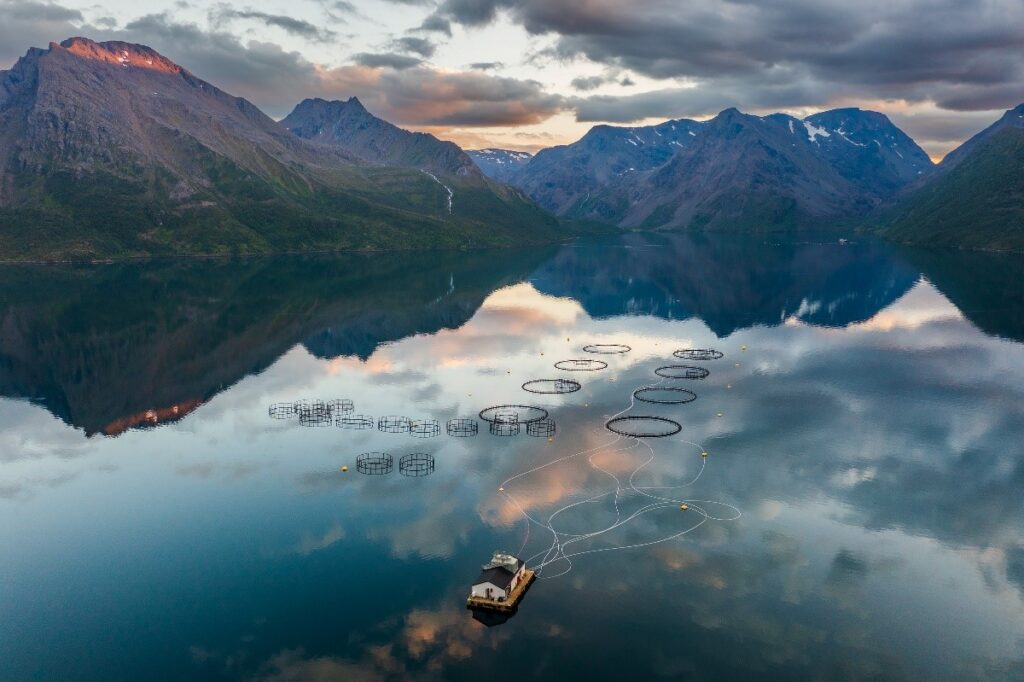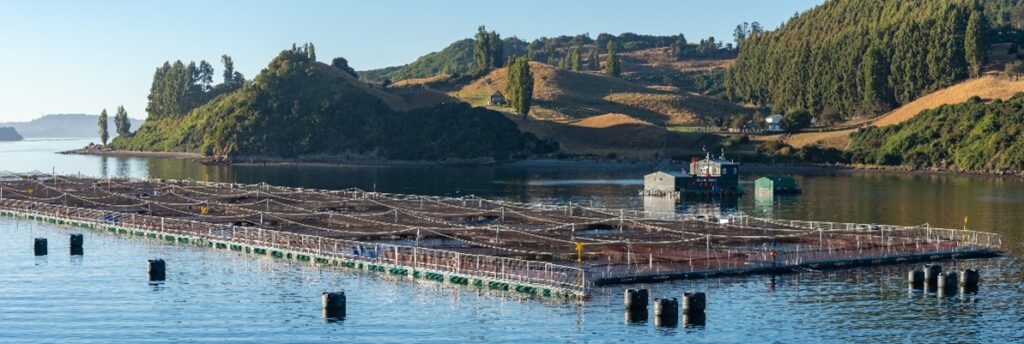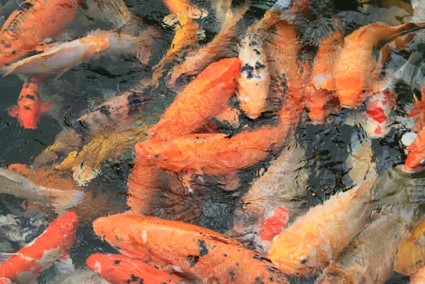
Fish farming on Øksfjorden in Loppa, Norway, in August 2022. Photo: Simo Räsänen.
According to the Blue Food Assessment, global demand for food from the sea, or blue food, has doubled since the early 2000s and is expected to double again by 2050.
The OECD-FAO Agricultural Outlook 2021-2030 says that, by 2030, the demand for seafood will exceed what can be sustainably caught from the wild. This is due to a number of factors, including population growth and change in dietary patterns, as well as the growing affluence of societies, where people are increasingly eating plant-based foods combined with seafood, which is often seen as a healthier alternative source of protein.
However, the ability of aquatic food systems to meet this growing demand depends, for one thing, on their resilience to climate change. Climate-driven constraints may lead to rising and more variable seafood prices, affecting fish consumers, especially the poor who spend a significant portion of their income on food.
The United Nations’ Food and Agriculture Organization (FAO) identifies important economic, policy, and environmental factors that may affect world fish markets over the next decade.
One concerning issue is overfishing and depletion of fish stocks. To address this challenge, possible solutions include promoting sustainable seafood choices like fish lower on the food chain, reducing food waste in production and consumption, and expanding aquaculture as a more sustainable method than wild-capture fishing.
The over exploitation of marine resources could have a number of negative consequences.
These include: biodiversity loss, as fish play a vital role in the marine ecosystem; economic losses, as the fishing industry is a major economic driver in many countries; and food insecurity, as seafood is a major source of protein for many communities.

Aquaculture in Chile. Image from Wikipedia, by Gordon Leggett
The NOAA defines aquaculture as the breeding, rearing, and harvesting of fish, shellfish, algae, and other organisms in various water environments.
Aquaculture serves multiple purposes, including food production, habitat restoration, and population rebuilding. Aquaculture can be categorized into two types: marine and freshwater.
According to Aquaticode, a company founded by Nacre Capital, aquaculture helps alleviate the burden on the environment. Aquatic species have high nutritional density and a significant proportion of their mass is edible. Furthermore, aquaculture has lower carbon dioxide (CO2) emissions, land usage, and water consumption than many other protein sources.
The company believes that the aquaculture industry will advance due to five major trends: selective breeding, alternative feed, precision farming, water recirculation systems, and Artificial Intelligence to facilitate decisions.
The Quantum Record reached out to Stian Rognlid, who is CEO at Aquaticode and works with AI-powered aquaculture, to ask him how much of a change is AI bringing about in this field, and what its prospects are with the fast technological advancement. He told us:
“A handful of mega trends are expected to help bridge the supply/demand gap, including artificial intelligence. The major breakthroughs are yet to come, but we are already seeing how AI unlocks value by enabling faster, better, and more consistent decision-making. It’s all about producing more with less. As an illustration, Aquaticode has developed an AI-powered machine capable of sorting 10,000 juvenile salmon per hour based on relevant performance traits.”
Mr. Rognlid makes an important note:
“While aquatic animals are highly nutritious, overfishing poses a real threat to the health of our oceans. Aquaculture offers a solution to this challenge. Salmon farmers consistently rank among the most sustainable protein producers. However, the pressing issue is that we need to double food production by 2050. Increasing production levels lead to a larger environmental footprint, and we are already exceeding the planet’s capacity. What brought us here won’t bring us there.”

Increasing reliance on seafood as a source of protein and nutrition could have both benefits and challenges. Image: Pxhere .
The article in Nature, The future of food from the sea, by Christopher Costello and co-authors (2020), discusses the future of seafood as a source of protein and nutrition.
Seafood has advantages, as it is diverse and has fewer environmental and health issues than land-based meat. It could play a significant role in meeting global meat demands.
However, concerns about climate change, overfishing, pollution, and unsustainable mariculture – which is the cultivation of marine organisms in their natural environment for food and other products – make sustainable seafood production seem challenging. The authors propose that changes in policies and practices, addressing regulatory barriers and perverse incentives, could support both food provisioning and conservation goals.
The realization of sustainable production potential will depend on policy reforms, technological innovations, and shifts in future demand.

How can we ensure that aquaculture is a sustainable solution for meeting growing seafood demand while minimizing environmental damage and protecting wild fish populations? Image: PxFuel .
To make aquaculture sustainable, we must address its environmental effects.
Measures to increase sustainability include locating farms wisely, reducing antibiotics and chemicals, and controlling waste.
Eco-friendly technologies like recirculating aquaculture systems (RAS) and integrated multi-trophic aquaculture (IMTA) help by recycling water and cultivating multiple species together, which increases efficiency. Care should be taken to minimize the risk of introducing non-native species, with processes for regulations and genetic monitoring. Sustainable feed production, animal welfare, and life cycle assessments are crucial.
Collaboration among industry, regulators, and stakeholders is essential to follow best practices and minimize environmental harm.
Sustainable seafood production not only provides environmental benefits but also generates social advantages like job creation and local economic development, especially in coastal communities.
It can help alleviate poverty and enhance the resilience of fishing-dependent communities. Organizations like the Aquaculture Stewardship Council and the Global Aquaculture Alliance have established internationally recognized standards to ensure responsible and holistic practices in aquaculture, considering the environmental, social, and economic consequences of the industry.
According to the FAO, innovative technologies play a vital role in driving sustainable aquaculture practices.
These include genetic technologies, which can, for instance, enhance desirable traits like disease resistance and growth rates – although this raises ethical, safety, and environmental concerns. Other examples include sensor technology, data analytics, and machine learning, which provide farmers with effective management tools for the correct stocking density in the farmed area, feed management, and disease control, while facilitating more informed decision-making. Aquaculture big data analytics aim to optimize both operational efficiencies and sustainability.
In their Ecology & Society paper Drivers of social acceptability for bivalve aquaculture in Atlantic Canadian communities, Shannon E. Wood and Ramón Filgueira show that the drivers of social acceptability for aquaculture include environmental, economic, and social factors. These include concerns about pollution and harm to aquatic vegetation and coastal and marine wildlife, job creation and economic benefits for the community, and community engagement and participation in decision-making processes.
Aquaculture is considered by some to be “the best source of sustainable livelihood for communities, as long as the technology is in place and environmentally friendly.”
Important challenges that the aquaculture operators and owners may face include lack of knowledge, high and low tides, and no reserve for unforeseen expenses, among others.
Sustainable aquaculture should encompass not only environmental aspects but also economic and social sustainability. Responsible aquaculture can support local economies while promoting the conservation and sustainable use of marine resources, easing pressure on wild fish stocks. However, regulatory and governance factors in aquaculture are essential for its sustainability, and to avoid negative consequences, such as unintended harm to the environment, society, and local economies.
It’s important to note that effective multi-stakeholder collaboration is vital for advancing sustainable aquaculture.
By involving diverse groups like farmers, government agencies, NGOs, researchers, and local communities, innovation and best practices can be promoted and common goals achieved.
Engaging marginalized stakeholders ensures equitable industry development and culturally appropriate approaches. Collaboration between the public and private sectors, through partnerships, enables investment in research and technology for sustainable development. Transparency and accountability are essential to prioritize the public interest and align with broader sustainability objectives.

Now, nothing is more important now than fighting climate change. Image: TheDigitalArtist.
According to Sánchez-Jerez and co-authors (2022), climate change may bring a number of negative consequences to the development of marine aquaculture, and potential damages to farming activities cannot be attributed to one single type of climate change.
To Lynne Falconer and co-authors (2022), climate change is already affecting food production worldwide, including aquaculture. They provide examples of specific consequences of climate change on aquaculture, such as sea level rise and saltwater intrusion affecting prawn production, extreme weather events damaging fish ponds, heatwaves decimating mussel production, and multiple stressors leading to increased salmon mortality rates. The authors argue that a comprehensive knowledge base can be used by the aquaculture industry, researchers, and policymakers as a foundation for more targeted and detailed climate change effect analysis, risk assessments, and adaptation planning.
The growing demand for seafood presents both opportunities and challenges for sustainable aquaculture, which offers a potential solution to meet global protein needs while minimizing environmental harm. However, steps need to be taken to ensure the sustainability of aquaculture.
Collaborative efforts among industry, regulators, and stakeholders are crucial in implementing best practices and minimizing threats to sustainability.
Innovative technologies hold great promise for driving sustainable practices, while social acceptance and community resilience can be enhanced through local economic development. Considering the risks of climate change, it is imperative to prioritize adaptation and resilience-building measures to safeguard the availability of nutritious seafood for the generations to come.



